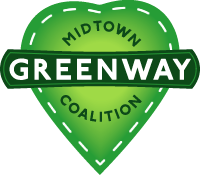A Greenway Streetcar
Good for the Greenway, Good for our Communities, Good for the Twin Cities Region
NEW! Check out this great article by Dara Moskowitz Grumdahl in MPLS-St. Paul Magazine about the potential Midtown Greenway streetcar.
Why a Greenway Streetcar?
The Hennepin County Regional Rail Authority purchased the "Chicago, Milwaukee and St. Paul Railroad Grade Separation" (now the Midtown Greenway) in 1993 with the intention of introducing public rail transit to the corridor.
Since 1999, the Midtown Greenway Coalition has advocated for the construction of a streetcar in the Greenway. A turf-track streetcar would improve the existing Greenway for all users, bring more people to the Greenway, provide speedy transit across town, and contribute to a more robust regional transportation system. It would also do the most to support economic growth and Lake Street businesses.
Safety
More people on the Greenway make it a safer place for everyone. By bringing in a streetcar line, and thereby hundreds to thousands more people a day into the corridor, we would increase the "eyes on the Greenway" and create an even safer corridor. Streetcar operators would also be equipped with radios to call in any sightings of unsafe behavior or other incidents.
Investment in the Midtown Corridor
Streetcars attract more new "choice" transit riders than do buses. As the Hiawatha LRT proves, there are tens of thousands of potential new transit riders that prefer rail over buses. This surge of new people will bring businesses excited to invest in walkable communities, and support exisitng businesses on Lake Street.
While buses are important -- and will likely always exist on Lake Street -- yet another bus line is not likely to bring many economic benefits to our neighborhoods and businesses along Lake Street.
Put simply, if all we care about is moving people along Lake Street, another bus line is fine. But if we care about economic development and supporting businesses on Lake Street, a Greenway streetcar is the only good option.
Rapid Transit
The Midtown Greenway Streetcar would run unimpeded by traffic for most of its route, allowing it to run quickly and reliably between the Midtown/Lake Street Hiawatha LRT station and the planned future West Lake Street Southwest LRT station.
Any viable transit improvement on Lake Street (rapid bus or streetcar) would bog down in rush hour. While the Alternatives Analysis will look at an LRT and a BRT with its own lane, neither option is likely to be selected. For Lake Street, it would come down to either a streetcar or a "rapid" bus, but both would operate in traffic. For anyone who knows Lake Street traffic, this means both wold come to a near halt during rush hour. How would that be much different than what happens to the current "express" bus on Lake Street?
Turf Tracks / Grassed Tracks
Turf tracks, or grass tracks, are standard rail tracks that are embedded in grass or turf surfaces as an alternative to ballasted or concrete-embedded rails. Turf track streetcar and LRT lines are common throughout Europe, and can be found in New Orleans and Kenosha, Wisconsin as well.
The Midtown Greenway Coalition advocates for the use of turf tracks for the Midtown Greenway Streetcar. This track style would preserve the “Green” in the Midtown Greenway through the beauty, water management, sound buffering, and heat-reflecting capabilities of plants and soil as compared to a ballasted track.
We also support a single-track in places where the Greenway trench is too narrow. A single track -- like the tram at the airport -- would be easily to coordinate, given that the Greenway has very few street cossings and no car traffic.

Turf-track streetcar in Kenosha, WI.
The Streetcar in the Historic District
The Midtown Greenway Coalition believes that it is important that the streetcar be built in a way that respects the historic nature of the trench it will lie within. Using sections of single track alignment, the streetcar line would be able to fit in the trench without the destruction of the sloped edges.
The Midtown Greenway became a rail corridor in the late 19th century, and at the time represented the southern edge of Minneapolis. As the city grew, the rail crossings became an issue for people and businesses in the area. There were years of debate between the City Council, local neighbors, and railroad officials on how to solve this problem. Proposals included moving the rail line out of the city all together and constructing an elevated line. Finally, in 1912 the Minneapolis City Council directed the railroad to construct a trench and crossing bridges to create grade-separated crossings.
The Greenway’s trench and the original bridges were built between 1912 and 1916. Today there are over 25 original bridges still standing, and most of the trench’s edge slope remains intact. The trench, original bridges, and other features from that era are part of the Chicago, Milwaukee and St Paul Grade Separation Historic District:
The Chicago Milwaukee and St Paul Grade Separation Historic District is a transportation district including a depressed railroad corridor trench and several adjacent buildings… between the eastern right-of-way of Humboldt Avenue South (as the western boundary) and the southern right-of-way of East Twenty-Eigth Street, where the railroad right-of-way meets the street (as the eastern boundary)… the boundary encompassed the area of land that contains the contributing resources—trench, bridges, buildings, and small-scale features that comprise the historic district. (CM and StP Grade Separation National Register of Historic Places Continuation Sheet, Section number 10, Page 1, 2005).
The Greenway is a historic district not only for its unique physical attributes, but also for what it represents about our city. It was one of the first major city planning projects in Minneapolis, and is a living example of the negotiations between the City Council, the railroad company, and the citizens living in South Minneapolis. Preserving the trench’s sloped edges will preserve the memory of the hard work of many Minneapolitans one hundred years ago.

